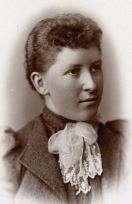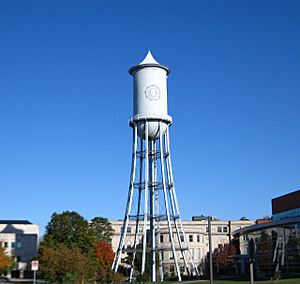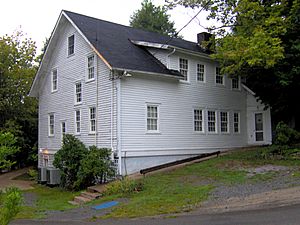Elmina Wilson facts for kids
Quick facts for kids
Elmina Wilson
|
|
|---|---|

1892 graduation photo
|
|
| Born |
Elmina Tessa Wilson
September 29, 1870 |
| Died | June 4, 1918 (aged 44) New York City, New York, U.S.
|
| Nationality | American |
| Other names | Elmina T. Wilson |
| Occupation | civil engineer |
| Known for | First woman to earn a four-year degree and a master's degree in civil engineering in the U.S. |
Elmina Wilson (1870–1918) was an amazing American engineer. She was the very first woman in the United States to earn a four-year degree in civil engineering. She didn't stop there! She also earned the first master's degree in civil engineering. Later, she became the first woman professor to teach engineering at Iowa State University (ISU).
One of her first big projects was helping design the Marston Water Tower on the ISU campus. After teaching for ten years, she moved to New York City to work for private companies. Wilson worked with several engineering and design firms, including those that designed skyscrapers.
Contents
Early Life and Education
Elmina Tessa Wilson was born on September 29, 1870, in Harper, Iowa. Her parents were Olive and John C. Wilson. She had five siblings, including her younger sister, Alda, who also became an engineer.
In 1892, Elmina made history when she graduated from Iowa State University (ISU). She received the first four-year civil engineering degree ever given to a woman in an American university. Just two years later, in 1894, Elmina earned her master's degree in civil engineering from ISU. Her sister Alda also graduated that same year with a bachelor's degree in civil engineering. Both sisters were strong supporters of women's education and their right to vote, known as suffrage.
A Career in Engineering
Soon after graduating, Wilson started working at ISU. She began as an assistant in the school's drafting room. The next year, she was promoted to an instructor.
Designing the Marston Water Tower
In 1895, Elmina worked with Professor Anson Marston on an important project. They designed the first elevated steel water tower to be built west of the Mississippi River. This tower, known as the Marston Water Tower, was finished in 1897.
The design of the 40-foot-tall (12-meter) and 24-foot-diameter (7.3-meter) water tower was special. It used eight columns instead of the usual four. This made the 162,000-gallon structure very safe. It was also the first steel, not wood, elevated tower west of the Mississippi River. The tower was listed on the National Register of Historic Places in 1981.
Teaching and Further Studies
After the water tower project, Wilson took a winter course in hydraulics (the study of how liquids move) at Cornell University. She then returned to ISU to teach physics. During her summer breaks, she worked with her sister Alda in Chicago. They did drafting work for the firm of Patton & Miller. For the next two winter breaks, she studied at Massachusetts Institute of Technology, earning a graduate degree.
She returned to ISU as an assistant professor of physics. She started publishing articles in the Iowa Engineer about testing different cement formulas. Most of the courses she taught focused on civil engineering, especially dealing with structures.
Moving to New York City
In the fall of 1903, Wilson and her sister Alda took a break from work. They traveled to Europe to study engineering and architectural designs. They mostly explored by bicycle, visiting countries like England, France, Germany, Greece, Italy, Scotland, and Switzerland.
When they returned in 1904, Wilson left her job at ISU. She moved to New York City to work for private companies. Her first job was with the James E. Brooks Company. In 1906, she started working on publications for the U.S. Department of Agriculture. She wrote a brochure called Modern Conveniences for the Farm Home. This brochure was published in many newspapers across the country. It talked about things like piping water pumped by a windmill into rural homes. It also suggested adding bathtubs with water from elevated tanks in attics or special pumps in basements.
Skyscrapers and More Travels
The next year, Wilson joined Purdy and Henderson, a famous engineering firm known for designing skyscrapers. She worked on the Flatiron Building and later the Met Life Tower. These are very famous buildings in New York City!
In December 1907, the sisters sailed back to Europe on the Adriatic ship. They spent six months studying architecture in France and Spain. After returning home, they worked together on designing a house in Ames, Iowa, for W. J. Freed and his daughter Kittie.
In 1911, Wilson was president of the New York Chapter of the Pi Beta Phi Alumni Club. In 1912, she was hired as a structural designer by the John Severn Brown Company. In 1913, the sisters planned another trip. They spent eight months studying in Germany, Italy, and Sicily.
Later Projects and Advocacy
In 1915, the sisters worked together on architectural and engineering drawings for the Teachers Cottage, also known as Helmich House. This was in Gatlinburg, Tennessee, at the Arrowmont School of Arts and Crafts.
Helmich House was designed in 1915. It was the first known architect-designed house in Gatlinburg, Tennessee. It was built to provide living quarters for teachers at the school. The house had modern features like the first furnace in Gatlinburg and running water. In 2007, the teacher's residence was added to the National Register of Historic Places.
Elmina Wilson, along with Nora Blatch, applied to become members of the American Society of Civil Engineers (ASCE). However, they were not accepted at that time because they were women. Blatch later took legal action to gain membership.
The Wilson sisters were also very involved with the Manhattan Woman's Suffrage Club. Elmina served as its president. Through this work, she met important leaders like Susan B. Anthony, Carrie Chapman Catt, and Eleanor Roosevelt. Because of their Iowa connections and their work for women's voting rights, the Wilson sisters became close friends with Carrie Chapman Catt. Alda later became Catt's companion and secretary.
Elmina Wilson passed away on June 4, 1918, in New York City. She was buried there.



